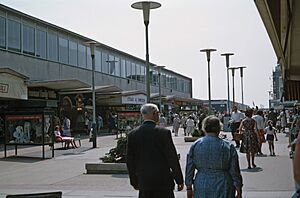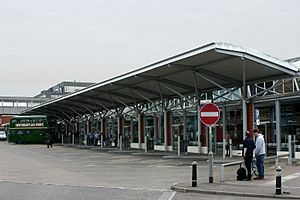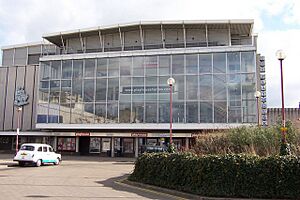Harlow facts for kids
Quick facts for kids
Harlow
|
|
|---|---|
|
Town and borough
|
|
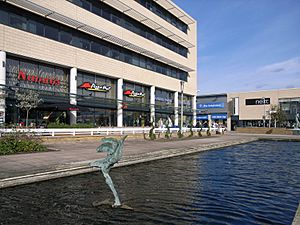
Harlow Water Gardens
|
|
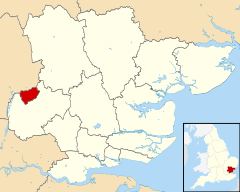
Shown within Essex
|
|
| Country | |
| Constituent country | |
| Region | East of England |
| Ceremonial County | Essex |
| Government | |
| • Type | Non-metropolitan district |
| Area | |
| • Town and borough | 11.79 sq mi (30.54 km2) |
| Population | |
| • Town and borough | 93,300 |
| Ethnicity (2021) | |
| • Ethnic groups |
List
|
| Religion (2021) | |
| • Religion |
List
44.7% Christianity
43.4% no religion 7.9% other 4% Islam |
| Postal code |
CM17–CM20
|
| ONS code | 22UJ |
| Website | www.harlow.gov.uk |
Harlow is a town and local area in the west of Essex, England. It was built as a new town after World War II. Harlow is located near the border with Hertfordshire. It sits on the south side of the Stort Valley, which has a canal section.
Old Harlow is a very old village. Many of its buildings are from the early Victorian period. A field there, called Harlowbury, has the remains of an old chapel. The M11 motorway runs to the east of the town. Harlow has its own shops and fun places. It is also a place where people live and travel to work in London or places like Cambridge and London Stansted Airport.
In 2011, Harlow had a population of 81,944 people. A large number of homes in Harlow are social housing. This was part of a plan after World War II to help families who lost their homes in London during the bombing.
Contents
- What's in a Name? The Meaning of Harlow
- Harlow's Past: A Look Back
- Green Spaces: Harlow's Environment
- Harlow's Economy
- How Harlow is Governed
- Getting Around: Transport in Harlow
- Healthcare in Harlow
- Learning in Harlow: Education
- Fun and Games: Sport and Leisure
- Art and Culture in Harlow
- Media in Harlow
- Famous People from Harlow
- Sister Cities
- Arms
- See also
What's in a Name? The Meaning of Harlow
The name Harlow has two possible origins. One idea is that it comes from old Anglo-Saxon words. 'Here' means "army" and 'hlaw' means "hill". So, it could mean "army hill". This might refer to Mulberry Hill, which was a meeting place.
Another idea is that it comes from 'here' and 'hearg'. 'Hearg' means "temple hill" or "mound". This could refer to an old Iron Age burial mound. Later, a Roman temple was built there.
Harlow's Past: A Look Back
Ancient Times in Harlow
The oldest signs of people in Harlow are from about 10,000 BC. These were found at a hunting camp. Later, people in the Neolithic (New Stone Age) and Bronze Age worked with flint here. They made tools like axe heads and scrapers. This shows that people were living and working in the area from about 5000 BC to 2000 BC. In Roman times, Harlow was a small town with a stone temple.
Harlow Through the Ages
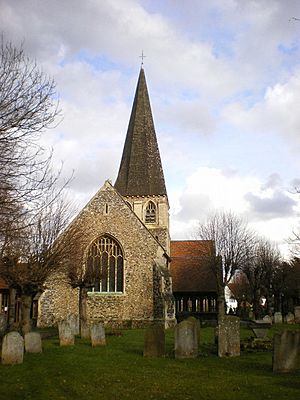
Harlow is mentioned in the Norman Domesday Book. This book was a survey of England from 1086. It talks about a mill, beehives, and animals. The mill is now a 300-year-old building and a restaurant.
The original village grew around what is now Old Harlow. Many old buildings are still there. For example, St Mary's Church is a very old church. There are also ruins of a chapel from Harlowbury Abbey.
Kingsmoor House is another old building from the 1700s. It was once a large home for important families. Later, it was a school and council offices. Now, it has been fixed up and turned into apartments.
Building the New Town
Harlow was chosen to be a new town on March 25, 1947. This was after World War II. Many towns were built to help people who lost their homes in London during the war. Other new towns included Basildon and Stevenage.
Sir Frederick Gibberd designed Harlow in 1947. He planned the town to fit in with the natural landscape. Sylvia Crowe, a landscape expert, helped design the green spaces. These "Green Wedges" cut through the town. They separate different neighborhoods.
The new town included the old market town of Harlow, now called Old Harlow. It also included villages like Great Parndon and Latton. Each neighborhood in Harlow has its own shops and community places. Many famous architects helped design buildings in Harlow. For example, Gerard Goalen designed the Our Lady of Fatima church.
Harlow has many cycle tracks. They connect all parts of the town to the center. Harlow also had Britain's first pedestrian-only shopping area. The Lawn, built in 1951, was Britain's first modern tower block for homes. It is now a protected building.
The town center and many shopping areas have been updated. Some original buildings, like the old town hall, were replaced. The Harlow Civic Centre and The Water Gardens shopping area were built in the 2000s.
Harlow's Modern Growth
Harlow has grown a lot since it became a new town. New areas like Sumners and Katherines were built in the 1970s. The Church Langley area was finished in 2005. The newest neighborhood, Newhall, is still growing.
The Harlow Gateway Scheme improved the area near Harlow Town railway station. It moved the football stadium and added a new hotel and apartments. Later, 530 eco-friendly homes were built. The Harlow Leisurezone was also built near the town's college.
There are also plans for new roads around the town. And there are ideas for more expansion to the north. This plan would extend the town into Hertfordshire.
The south of the town center has also been updated. The new Civic Centre and the Water Gardens were redeveloped. However, some main shopping areas have struggled.
In 2011, the government created an enterprise zone in Harlow. This zone helps new businesses grow. It has two main sites: Templefields and London Road. In 2022, Harlow Council received £23.7 million to improve the town. This money will help build a new bus station and improve Broad Walk.
Green Spaces: Harlow's Environment
Harlow New Town has many green spaces. More than one-third of the area is parkland or fields. The "Green Wedges" were part of the original design. They provide open spaces for nature and fun. They also separate different neighborhoods. About 23% of Harlow is Green Wedge. These areas are protected from building.
The town is also surrounded by Green Belt land. This land is protected to stop cities from growing too much. About 21% of Harlow is Green Belt.
Harlow Town Park is a very large park, almost 1 square kilometer. People have enjoyed this park for over 50 years. It is located between the town center and the railway station.
Harlow is known for being one of the first places to combine modern town planning with nature.
Harlow's Economy
Harlow was first planned to have many jobs in manufacturing. Factories like those at The Pinnacles and Templefields were big employers. But like other places, manufacturing has decreased. Harlow has had to change.
One old factory made biscuits for over 50 years. It closed in 2002. Now, smaller businesses are on that site. At its busiest, the biscuit factory employed over 500 people.
Companies like Raytheon and GlaxoSmithKline have large offices in Harlow. In 2017, Public Health England bought a site from GlaxoSmithKline. They plan to move many jobs there.
Nortel used to have a big site in Harlow. This is where Charles K. Kao helped develop optical fibre data transmission. Nortel still has a presence, but it is smaller. Now, other electronics and education companies are there. Onlinegolf, a big online golf store, is also based in Harlow.
Harlow has a higher number of people living in social housing. This means many homes are owned by housing associations or the local council.
How Harlow is Governed
Harlow has two levels of local government. These are Harlow Council and Essex County Council. The Harlow Council has been led by the Conservative Party since 2021. Its main office is at the Harlow Civic Centre.
The Member of Parliament (MP) for Harlow is Labour Chris Vince. He was elected in the 2024 general election.
Getting Around: Transport in Harlow
Train Travel
Harlow has two railway stations: Harlow Town and Harlow Mill. Trains from these stations go to London Liverpool Street and Cambridge. Harlow Town is also a stop for the Stansted Express. This train goes between London and Stansted Airport. All trains are run by Greater Anglia.
Buses also go from the town center to Epping tube station. This station is on the London Underground's Central line. In 2021, there was a plan to extend the Central line to Harlow. This would make travel to London faster.
Roads and Motorways
You can reach Harlow from junctions 7 and 7a of the M11 motorway. This motorway goes from London to Cambridge. Junction 7a opened in 2022. The M11 was originally planned to be on the west side of Harlow. But it was built on the east side instead. Sir Fredrick Gibberd, who designed Harlow, was very upset about this change.
The M11 motorway makes it easy to get to Stansted Airport. It also connects to the A120 and the M25 motorway. The A414 runs through Harlow. This road connects the town to other places like Hemel Hempstead and Maldon. The A1184 road goes to Bishop's Stortford.
Air Travel
Harlow is only about 10 miles from Stansted Airport. Many people who work at the airport live in Harlow. There were plans to build a second runway at the airport, but these were stopped. Later plans to expand the airport were also rejected.
Bus Services
Harlow bus station is a main point for the town's bus network. It also serves as a hub for the local area. The current bus station was built between 2001 and 2003. It has 15 bus stops.
In 2022, Harlow Council announced plans to rebuild the bus station. This project will cost £15 million. It will also include a new transport and cycle hub. Construction started in May 2024.
Arriva Herts & Essex runs many local bus routes. They also go to places like Bishop's Stortford and Chelmsford. Arriva also runs the Greenline 724 route. This bus goes between Harlow and Heathrow Airport.
Central Connect also runs local services in Harlow. They connect to towns like Epping and Cheshunt. First Essex operates a few routes too. There is also a National Express coach service from Stansted Airport to Oxford.
Harlow First Avenue Multi-Modal Corridor
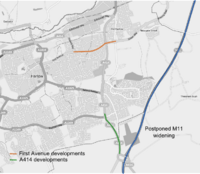
Developments in and around Harlow.
|
|
| Location | Essex |
|---|---|
| Proposer | Essex County Council |
| Cost estimate | £4.4 million (2008) |
| Completion date | February 2010 |
| Geometry | KML |
Essex County Council worked on improving Harlow's First Avenue. This was to reduce traffic and make transport better for the Newhall homes. The project included building a shared path for bikes and walkers. It also improved bus services along First Avenue.
Healthcare in Harlow
Harlow has the Princess Alexandra Hospital. It is located near The High, which is the main town center. This hospital has a 24-hour Accident & Emergency department.
Plans to rebuild the hospital were made in 2019. In May 2023, it was announced that the hospital would be rebuilt by 2030. However, these plans are currently being reviewed.
Learning in Harlow: Education
Harlow has seven state-funded secondary schools:
- Stewards Academy
- Mark Hall Academy
- St Mark's West Essex Catholic School
- Burnt Mill Academy
- Passmores Academy
- Sir Frederick Gibberd College
- BMAT STEM Academy
St. Nicholas School is a private school in Harlow. Harlow College offers sixth form and further education. St Mark's West Essex Catholic School and BMAT STEM Academy also have sixth forms.
Brays Grove Community School closed in 2008. The site was rebuilt into a new Academy. Passmores School moved there in 2011 and became Passmores Academy.
In the 1980s, two other secondary schools closed. Their sites are now used for other purposes. Harlow College is a major education center. It offers many subjects, including GCSEs, A-Levels, and vocational courses. The college is also building a new university center with Anglia Ruskin University.
An international campus of Memorial University of Newfoundland is in Old Harlow. Passmores Academy was featured in the TV series Educating Essex.
Sir Frederick Gibberd College
Sir Frederick Gibberd College opened in 2019. It was named after the architect who designed Harlow. The school was built using prefabricated modules. However, it had to close in August 2023 due to problems with its structure. The school will be demolished and rebuilt.
Fun and Games: Sport and Leisure
Cricket in Harlow
Harlow Town Cricket Club started in 1960. They play at Ash Tree Field. The club has junior teams and a girls' team. Their clubhouse was recently updated. This helps more women and disabled people play cricket.
Harlow has four cricket clubs. Harlow Cricket Club is in Old Harlow. Netteswell and Burnt Mill Cricket Club is a social team. Potter Street and Church Langley Cricket Club also play in the area.
Football in Harlow
The town's football club is Harlow Town F.C.. They play in the Isthmian League. The club is famous for its great run in the 1979-80 FA Cup. They beat bigger teams like Southend United and Leicester City. They were finally knocked out by Watford.
The club built a new stadium in 2006 called The Harlow Arena. Les Smith, a Harlow resident, played for Great Britain in the 1992 Paralympic Games. He was one of the first disabled people to become a qualified football coach.
Other Sports
The Harlow Greyhound Stadium hosts dog races and other sports events.
Harlow Rugby Football Club moved to a new location in 2017. Their old site is now a housing estate. The first team plays in the London and South East Division IIl North East league.
Harlow has a leisure center called the Harlow Leisurezone. It was built in the late 2000s. It replaced the old Harlow Sports Centre. The town also has a skate-park. It was built with over £300,000 in funding. The park has a bowl and a street course.
Art and Culture in Harlow
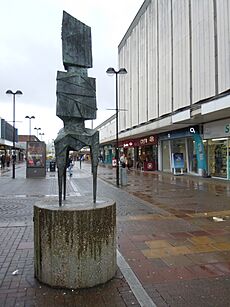
Harlow has a large collection of public sculptures. There are over 100 sculptures by famous artists like Auguste Rodin and Henry Moore. Many are owned by the Harlow Art Trust. This group was started in 1953 by Frederick Gibberd. He wanted everyone in the new town to enjoy great art. Most sculptures are outdoors in shopping centers, neighborhoods, and parks.
In 2009, Harlow Council decided to call Harlow 'Harlow Sculpture Town'. It is known as "The World's First Sculpture Town".
The Gibberd Garden is also in Harlow. It was the home of Frederick and Patricia Gibberd. It is a beautiful garden with some of their private sculpture collection. The Gibberd Gallery shows art in the Civic Centre.
Harlow's Playhouse Theatre hosts shows and live comedy. It is also home to "Livewire Theatre," a group that helps young people get involved in arts.
Harlow has a local museum. It shows exhibitions and artifacts about Harlow's history. The museum is in a 16th-century manor building with gardens. Entry to the museum is free.
Harlow is mentioned in the song "Get 'Em Out by Friday" by the band Genesis. The album Pram Town is a concept album about Harlow.
The music venue The Square was once in Harlow. It was named one of the top small venues in the UK. But it closed in 2018 for redevelopment.
Media in Harlow
Harlow receives TV signals from BBC London and ITV London. Local radio stations include BBC Essex and Heart East. Harlow Hospital Radio broadcasts to patients at the Princess Alexandra Hospital.
Local newspapers include Harlow Guardian (print) and Your Harlow (online).
Famous People from Harlow
Sister Cities
Harlow is connected with these towns:
- Havířov, Czech Republic
- Prague 15, Czech Republic
- Vélizy-Villacoublay, France
- Stavanger, Norway
- Tingalpa, Australia
Arms
|
See also
 In Spanish: Harlow para niños
In Spanish: Harlow para niños


